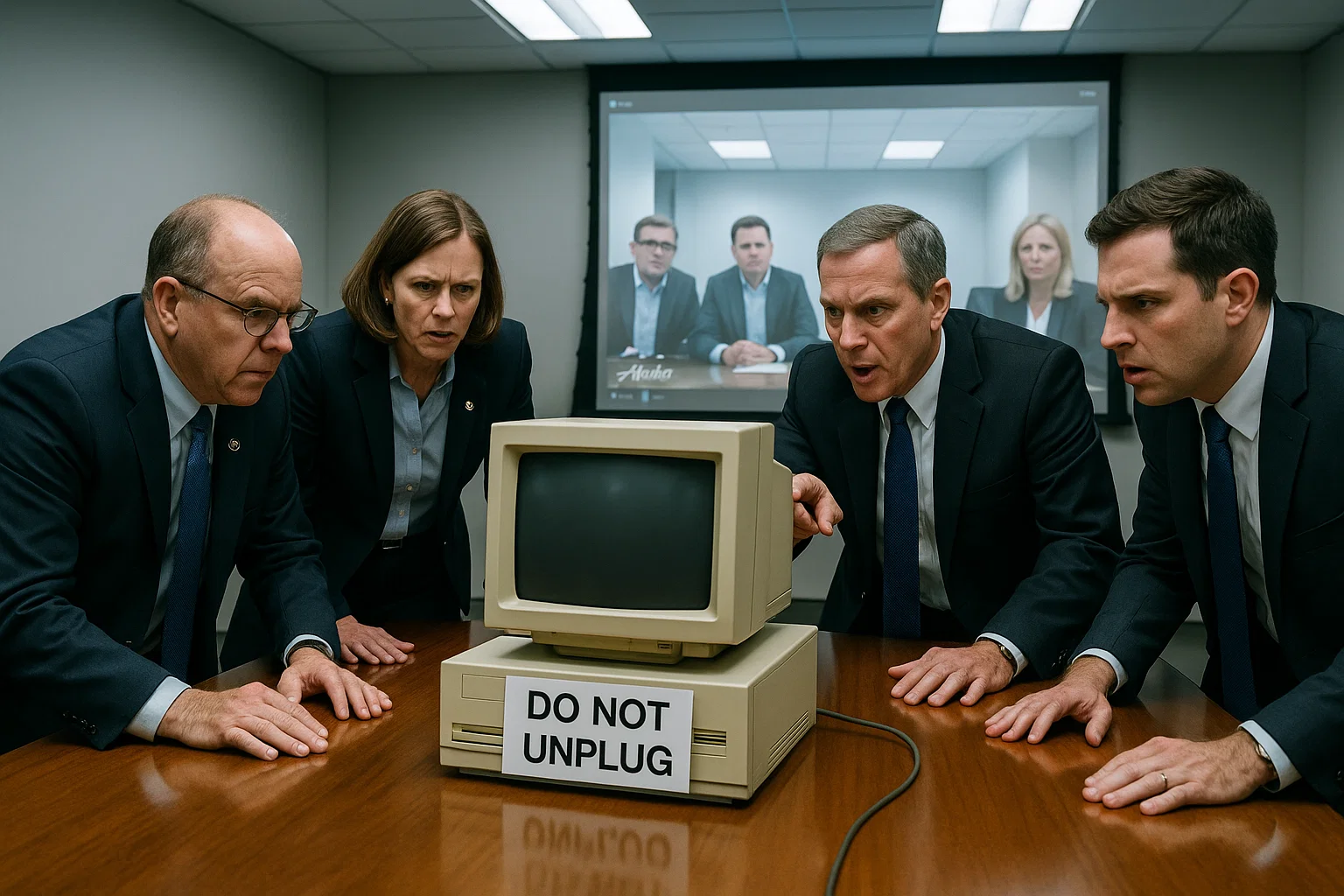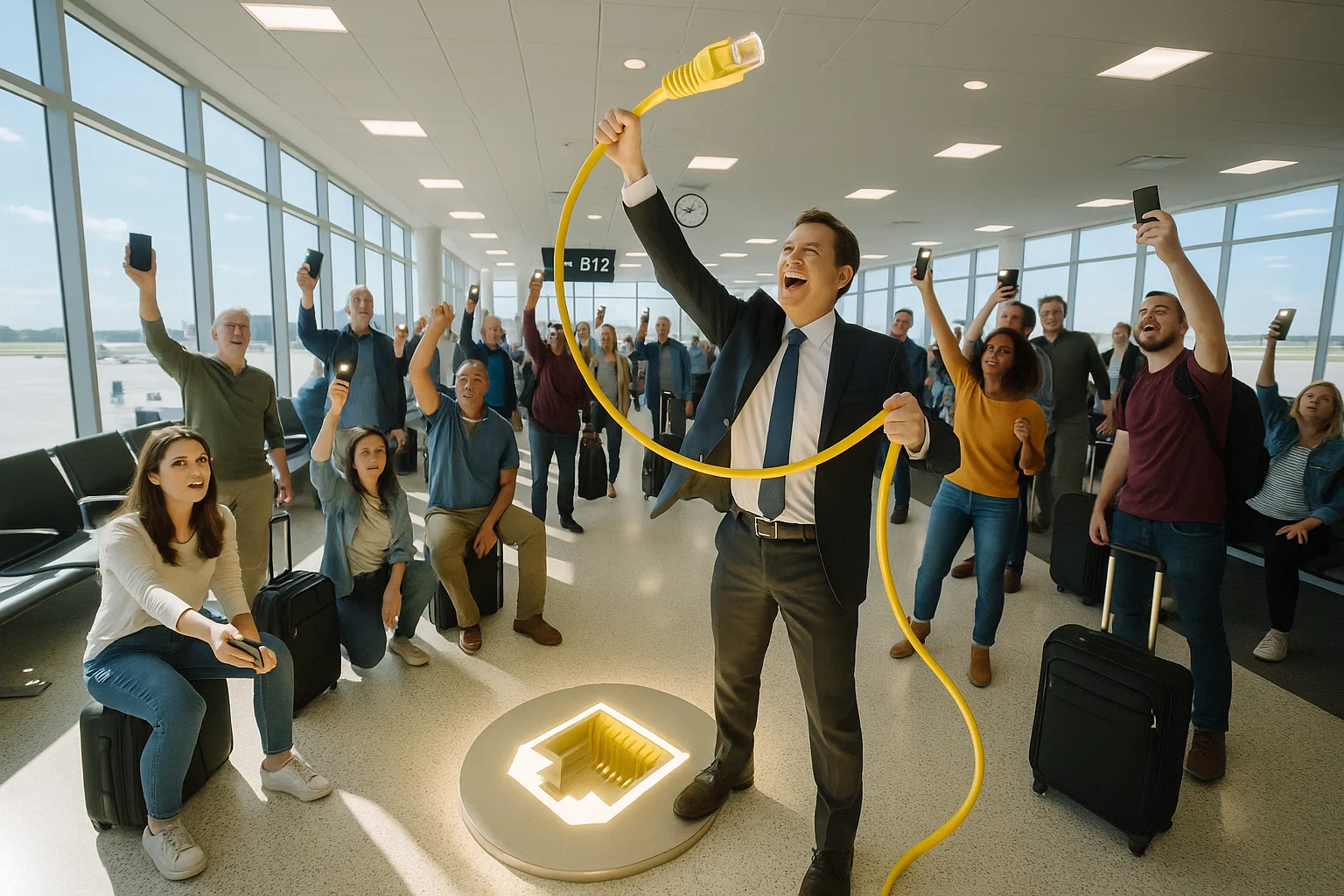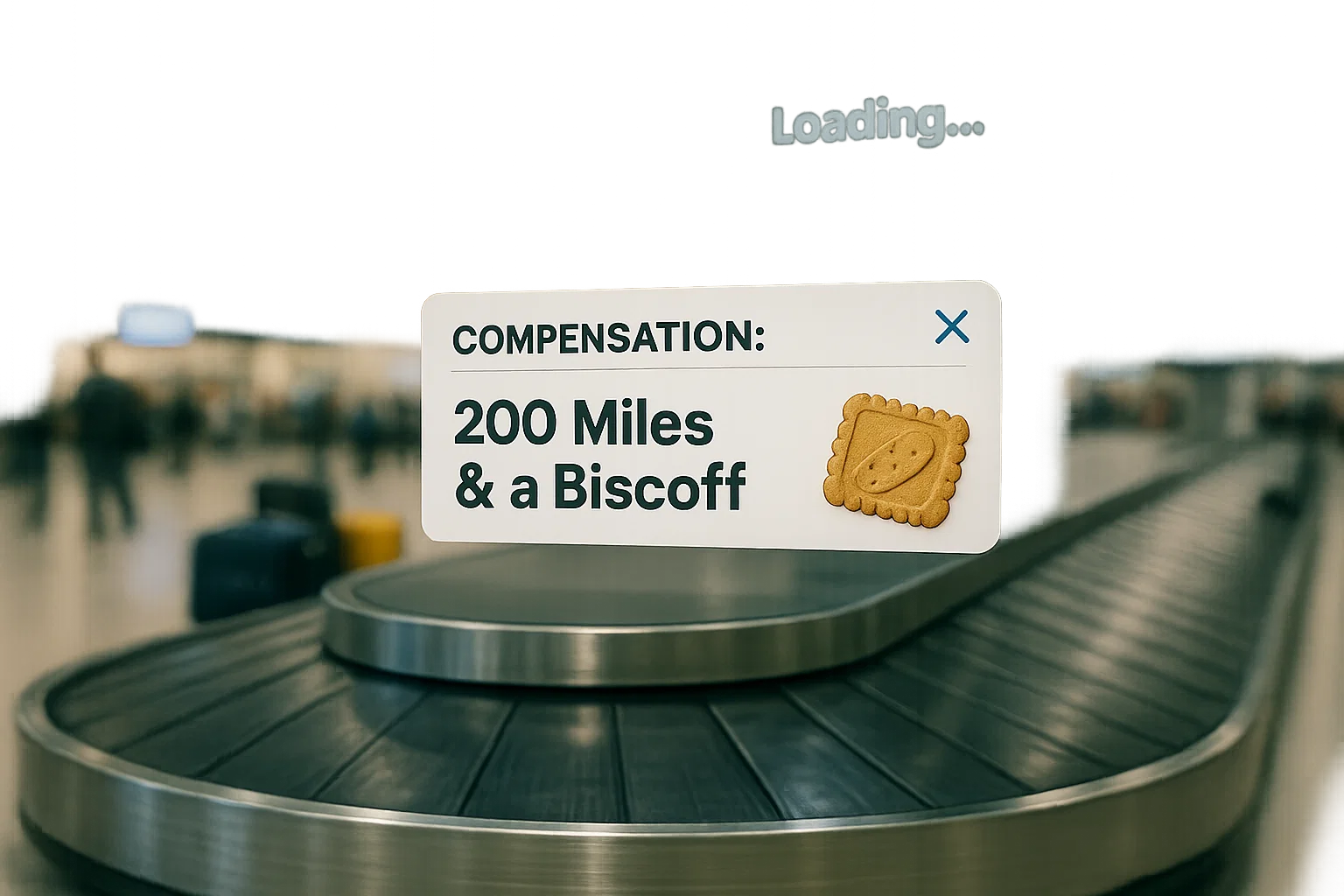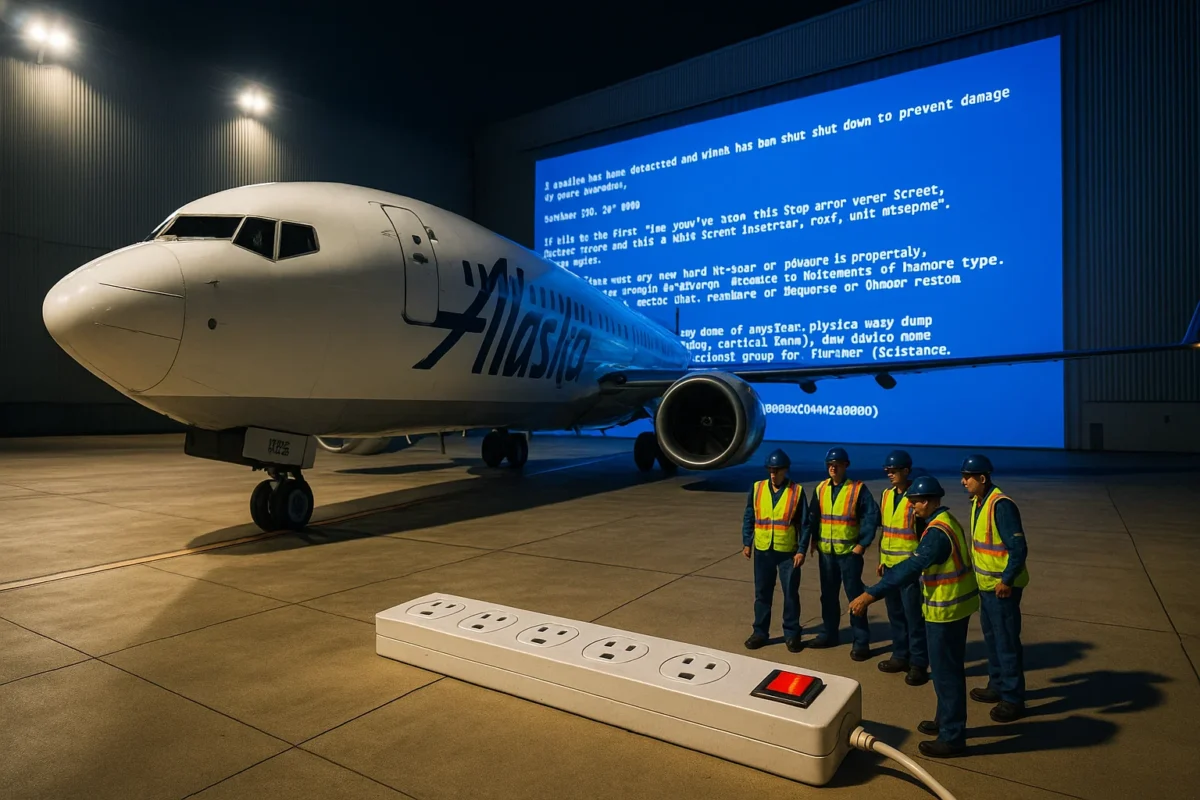The Day the Sky Rebooted

SEATTLE, WA — At precisely 8:03 p.m. Pacific on July 20, 2025, Alaska Airlines discovered the fastest route to carbon neutrality: it simply switched off every airplane it owns. The carrier asked the Federal Aviation Administration for a coast‑to‑coast ground stop, halting 325 jets and instantly achieving net‑zero emissions, if only by accident. According to the company’s own “multi‑redundant” press release, a single hardware component “failed spectacularly,” a phrase aviation historians usually reserve for engine fires and UFO sightings—never for a blinking beige server the size of a dorm fridge.
Within minutes, cable news crawls screamed “NATIONWIDE MELTDOWN” while social media erupted with blurry photos of stranded aircraft lined up like Costco carts. Time magazine solemnly reminded readers that nearly 13,500 passengers were suddenly living the reboot cycle in real time. Yet the airline insisted that safety was “never compromised,” because if nothing leaves the gate, nothing can crash. Philosophers applauded the logic; travelers did not.
Tier‑1 Help Desk vs. 737 Cockpit

Captain Amy “Could‑Have‑Been‑Somewhere” Davis spent the evening on hold with a cheerful technician named Brandon, who dutifully read from page one of the troubleshooting binder: “Have you cleared your cookies, rebooted your modem, and verified you are running Windows 95 or later?” Pilots obliged, dutifully power‑cycling multimillion‑dollar avionics while flight attendants offered complimentary apologies and eight pretzel sticks. Meanwhile, CBS News reported that more than 200 flights vanished from departure boards, replaced by the ancient runes “SEE AGENT.”
Engineering sources later admitted to KOMO‑TV that the airline’s reservation system still relies on a database named “reservations_final_FINAL(2).mdb,” last modified during the Y2K scare. The file now rests comfortably in a recycling bin awaiting heroic restoration or, failing that, a Viking funeral.
Ctrl‑Alt‑Del Diplomacy: FAA Enters the Chat

Once the outage surpassed the “minor inconvenience” threshold—roughly twelve seconds—the FAA convened an emergency Zoom featuring seven deputy chiefs, three feral cats, and one broken webcam pointed at the ceiling. In the call, Alaska executives swore this was “not a cyber‑attack”, as hackers generally demand cryptocurrency, not universal gate holds. The agency responded by emailing a 54‑page PDF titled “Basic Computer Skills for Airlines,” which includes helpful tips like “Try plugging it in” and “Don’t let Gary spill LaCroix on the server again.”
Fox Business later revealed that the FAA’s own network runs on similarly creaky infrastructure, requiring staff to authenticate via Netscape Navigator and swear on a floppy disk. Still, regulators triumphantly announced service would resume “soonish,” which in bureaucratic parlance means anything between three hours and the heat death of the universe.
Gate‑C2 Reset Rituals: Passengers Take IT Into Their Own Hands

At Seattle–Tacoma’s Gate C2, a grassroots tech cult materialized. Dozens of frequent flyers formed a circle around the terminal’s lone power outlet, chanting “Control! Alt! Delete!” while waving smartphones set to airplane mode for dramatic effect. A wandering yoga instructor offered to realign the network’s chakras, but only if Alaska upgraded him to Premium Class. According to Alaska Public Media, similar scenes unfolded in Anchorage, where stranded tourists attempted to barter salmon jerky for a seat on any functioning dog sled headed south.
Competing airlines looked on with a mixture of sympathy and opportunism. One Delta gate agent allegedly wagged a boarding pass and whispered, “Our system runs on two floppy disks.” Meanwhile, Newsweek counted more than 150 delays by dawn, each accompanied by public‑address announcements beginning, “We apologize for the inconvenience,” and ending, “Honestly, we blame Mercury retrograde.”
The Hero Intern and the Mystery Plug

Deep inside a data center somewhere between Tukwila and the Upside Down, 19‑year‑old summer intern Javier R. (badge title: “Spare Brain”) followed a trail of blinking red LEDs to a dusty power strip. One lone plug hung loose, swinging in the air like Chekhov’s Extension Cord. Javier, empowered by three semesters of computer science and one viewing of “Hackers,” reinserted the prodigal plug. Instantly, monitors flickered back to life, printers spewed ASCII art, and a distant rumble signaled jet engines roaring awake.
Company lore now hails Javier as “The Plug Whisperer,” and the San Francisco Chronicle reports that Alaska has offered him lifetime MVP Gold status—redeemable on any flight not simultaneously cancelled for “scheduled spontaneity.” Insiders concede the outage might have lasted days had Javier not Googled “why server go dark” on his phone after noticing there was no guest Wi‑Fi in the data center. Truly, necessity is the motherboard of invention.
Reboot Complete. Now Please Accept 200 ‘We’re‑Sorry’ Miles

By 11 p.m., Alaska lifted the ground stop and rolled out the red carpet of restitution: a blanket credit of 200 Mileage Plan points—roughly enough to upgrade one zone on the in‑flight Sudoku app. Passengers also received a digital coupon for “One (1) Complimentary Biscoff,” though international press noted the fine print: cookie may be substituted with “cookie‑flavored optimism” if supply chains falter.
In a victory lap teleconference, executives proclaimed the ordeal proof of “operational resilience,” stressing that their systems are now “triple‑redundant,” meaning they’ve purchased two extra power strips and labeled them. Future fail‑safes include a laminated sign reading “DO NOT UNPLUG THIS THING” and a Jolene‑the‑Janitor training video titled “Vacuuming: Friend or Foe?” For travelers, the moral is clear: always pack patience, snacks, and a spare surge protector—just in case America’s fifth‑largest carrier forgets where it left its cord again.
Enjoyed the spectacle?
Follow us back to The Takeoff Nap for more high‑altitude absurdity—and don’t worry, we reboot far more often than Alaska Airlines.
- Discover the humor and potential pitfalls of automated support in our latest piece, AI Customer Service: Now With 100% More Sarcasm!, where AI meets sarcasm in customer service.
- Curious about how airlines are stepping into an eco-friendly future? Check out Fly Backwards to the Future: Airlines Offer Carbon Negative Flights to see how they’re offering flights that are carbon negative.
- If you’re intrigued by the concept of privacy in the skies, don’t miss our article Introducing Privacy Flights: Be Alone, But Not Really (Because Big Brother Is Watching) for a deep dive into this unique travel experience.
- Explore the bold proclamation where President-Elect Trump Declares: “All Airlines Are Now American Airlines” reshapes the identity of all airlines under one banner.
- Find out why the New York Times agrees that Elon Musk to blame for Southwest woes points a finger at Elon Musk for recent disruptions in the airline industry.

